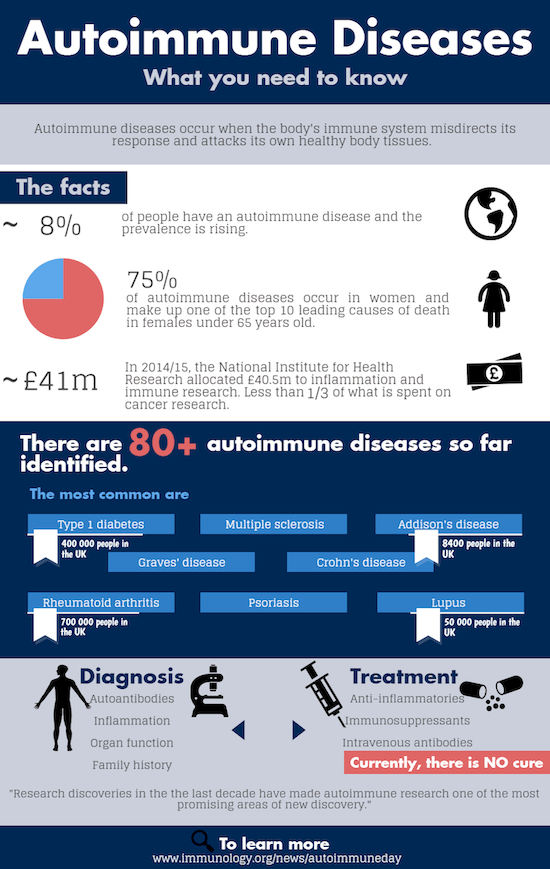
I’m waiting to see a rheumatologist to figure out if I do in fact have an autoimmune disease. In the meantime, I wanted to talk a bit about what autoimmune diseases are.
Autoimmune diseases occur when elements of the body’s natural immune system recognize certain types of normal cells in the body as foreign. The immune system will then attack these cells much like it would attack an infectious agent (e.g. bacteria, virus) or a substance you’re allergic to. Depending on the particular illness, difficult components of the immune system may be involved.
The exact cause of autoimmune diseases isn’t known, and it appears to be a complex mix of genetics, environment, and probably just plain bad luck. Women are at higher risk than men, particularly women of childbearing age. Family history matters, but it doesn’t necessarily have to be the same illness. Any type of autoimmune condition running in the family can boost your susceptibility. Both of my parents have had autoimmune conditions at some point.
Examples of autoimmune disease
There is a wide array of different autoimmune conditions, some of which people may not necessarily recognize as such.
- Type I (juvenile-onset) diabetes occurs because the immune system attacks insulin-producing cells in the pancreas.
- Celiac disease is an autoimmune disease in which the presence of gluten triggers the body to mount an autoimmune attack on the intestinal lining. This is entirely different from a gluten allergy.
- Crohn’s disease and ulcerative colitis also affect the gastrointestinal tract.
- Rheumatoid arthritis is autoimmune, unlike the more common osteoarthritis, which is not.
- Multiple sclerosis is likely at least in part autoimmune, and the myelin sheaths on nerve cells are under attack.
Diagnosing autoimmune conditions
What’s involved in making the diagnosis varies depending on the particular condition, and often it’s not easy. Sometimes the immune system will make antibodies as a way to target the part of the body it’s attacking, and the presence of these antibodies in the blood can aid in diagnosis. Blood tests for things like antibodies or other inflammatory markers vary in sensitivity and specificity, so it’s often a matter of trying to fit multiple different puzzle pieces together to find the best explanation.
Some autoimmune conditions have quite specific symptoms, but in many cases, symptoms can be vague and non-specific. It can sometimes take years for people to be diagnosed. Type I diabetes is an example of a condition that can be diagnosed relatively quickly, while celiac disease often takes a long time to be diagnosed. Sometimes, certain symptoms will make diagnosis easier; for example, there’s a classic “butterfly” patterned rash on the face that is quite distinctive to lupus. However, not everyone with the disorder presents with that symptom.
What might be happening with me
My lab results show that I have anti-nuclear antibodies (ANA), which means my body is making antibodies that target cell nuclei. The level of antibodies I have in combination with my various physical oddities makes it likely (although not certain) that I have an autoimmune disease. The lab also looks at the fluorescence pattern under a microscope, and the pattern they see can be indicative of some of the types of illness that may be going on. They saw two different patterns with mine, which point toward lupus, Sjögren’s syndrome, or mixed connective tissue disease, among a few others. I was tested for two more types of antibodies that are more specific to lupus, and those were negative, but around 1/3 of people with lupus don’t have those antibodies.
Lupus targets connective tissue throughout the body, and it can affect various organs. The kidneys are sometimes a target, which is why Selena Gomez (who has lupus) required a kidney transplant not long ago.
The hallmark symptoms of Sjögren’s syndrome are dry mouth and dry eyes, due to the body attacking the salivary and tear glands. Tick both of those boxes for me. The thing is, though, the dry mouth corresponds perfectly in time to when I started lithium around 6 years ago.
The dry eye matches up exactly with when I had laser eye surgery revision in 2015. I had LASIK done in 2006, but over time my vision got worse, so I had revision surgery in 2015 only on my right eye. The surgeon wasn’t able to do LASIK, so he ended up having to do PRK surgery, which has a greater risk of complications including, you guessed it, dry eye. My optometrist is very on the ball (eyeball, I suppose) and I’ve been seeing her for years, so I’ve made an appointment to have her check out my eyes and see if there’s anything funky going on.
Management of autoimmune conditions
Treatment varies from condition to condition, but what holds true pretty much across the board is that it’s a matter of chronic management rather than treatment and resolution. Type I diabetes is managed by replacing the insulin the body is unable to make. Celiac disease can be managed by avoiding gluten, but that doesn’t take away the damage that has already occurred.
Many autoimmune conditions are managed by immunosuppressant medications to try to calm down the overactive immune system. The drugs used for a particular condition would depend on what specific components of the immune system were working overtime.
I’m curious to see how it will go with the rheumatologist. My gut instinct is lupus since it seems like it would explain some of the weird things I’ve been experiencing, but it’s really not an area I know enough about for my gut to have any idea what it’s talking about. So we shall see.